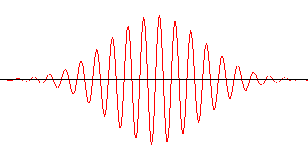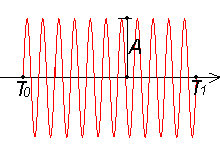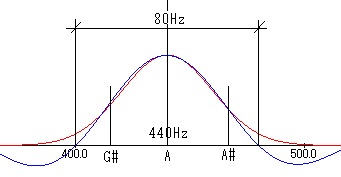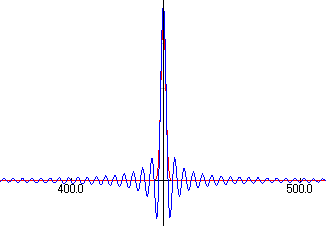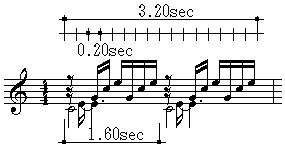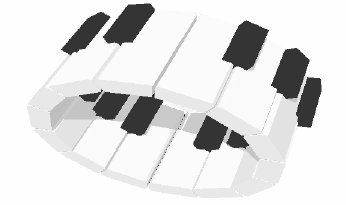
|
In quantum physics, the Heisenberg Uncertainty Principle expresses a limitation on accuracy of simultaneous measurement of observables such as the position and the momentum of a particle. (1927) |
|
Kurt Gödel's Incompleteness Theorem says that .... "any precise mathematical system must contain some statements that are neither provable nor disprovable by the means allowed within the system". (1931) |
In 1916 Einstein published his general theory of relativity. In it he proposed that gravity is not a force but a curved field in the space-time continuum that is created by the presence of mass. People were astonished by the fact that space and time are under relativity. Even though, the world could stay ease within the determinism where there was a general algorithmic procedure for resolving all mathematical questions.
But since Heisenberg's discovery, Isaac Newton's laws of motion has not been used to predict accurately the behavior of single subatomic particles. The world was then suffered from this uncertainty. Gödel gave an additional blow to the people's mental world with the incompleteness.
Relativity, Uncertainty and Incompleteness!
Wow! We are free from the determinism!
Roger Penrose, Professor of Mathematics at Oxford University and a physicist, now happily says, "We cannot create any kind of new artistic sensitivity however we may accumulate many times of calculations. Art is a non-computable physics."
I would like to say, "Music is a non-computable physics, too".
But over the centuries musicians, mathematicians, theorists, thinkers, experts and amateurs have been suffered from the comma which is the difference between a perfectly tuned octave and the octave resulting from a tuned circle of fifths. Many great people have been trying to create the perfect scale in vain. Mathematics easily proves that perfection is not possible. Any solution does not exist. Musicians, especially pianists, have been accused of using the Equal Temperament for thier pianos because the Equal Temperament is said to be an anti-musical compromise which leaves each key equally damaged and none perfectly in tune.
This comma has put a curse on music.
ΔxΔp ≥ h ⁄ (4π) x ; position
p ; momentum
Δx, Δp ; the standard deviation of x, p
h ; the Planck's constantIf Δx → 0, then Δp → ∞.
An accurate measurement of one observable characteristic involves a large uncertainty in the measurement of the other. This is the Heisenberg Uncertainty Principle .
Can this be applicable to the sound wave? This is for the behavior of single subatomic particles, isn't it? The Planck's constant "h" is too small to be took into consideration in our daily life.
h = 6.6261 × 10-34 JsA tennis ball (about 50g) with a 180km/h ( 50m/s ) speed which was served by Ms. Martina Hingis would have any uncertainty about its location? Actually No! In case of Δv=0.01m/s, the quantum deviation Δx is about 2*10-31m or 0.0000000000000000000000000002mm.
Sound is the result of periodic fluctuations in air pressure propagating through the ordinary atmosphere. The sound waves are in the ordinary world. You may think that the Uncertainty Principle has nothing to do with music. But the formula can be transformed into the relation between time and frequency of waves.The position and momentum of a wave in space have been changed in form to the time and frequency of a wave. Here is a sound wave as a time-varying signal. Now we have found out the fact that it is impossible for us to know the exact frequencies in our sound wave at an exact moment in time. When Δν is 0.1Hz, Δt should be more than 1 /(4π *0.1) sec which is about 0.80 sec.
ΔxΔp ≥ h ⁄ (4π) p = mv → Δp = m Δv v = velocity (m/s) E = m v2/2 → ΔE = m v Δv = m Δv v ΔE = Δp v = Δp (Δx/Δt) = (Δp Δx)/Δt ΔE ≥ (h /(4π))/Δt ΔE Δt ≥ h /(4π) E = h ν → ΔE = h Δν ν = frequency(1/s) = f, E for a photon h Δν Δt ≥ h /(4π) Δν Δt ≥ 1 /(4π)
Here, there is no "h". Δν ≥ 1 /(4π Δt)
Δt ≥ 1 /(4π Δν)
Δt and Δν are the standard deviation of t and ν.
Middle C of the equal temperament is calculated approximately as 261.6256Hz. If you want to determine C with this precision 0.0001Hz, you need Δt of 800 sec, or 13 min 20 sec. If you want to get the exact Middle C, you need an infinite time and a continuous wave of C.
In other words, theoretically we cannot get the perfect fifth tone with a frequency f ( that is ν ) from a root tone with a frequency f0 by calculating f = f0 × 3/2.
In another treatment, the "uncertainty" of a variable is taken to be the smallest width of a range which contains 50% of the values, which, also in the case of normally distributed variables, leads to a lower bound of
Δν Δt ≥ 1/( 2π ) for the product of the uncertainties. For different types of wave packets and for other treatments, the uncertainty can be set to a much lower bound.
a normal distribution wave
the minimum wave packetΔν Δt ≥ 1 /( 4π ) is for the case of the normally distributed variables or the minimum wave packet like a photon and a wave with the standard deviation form.
Δν Δt ≥ 1 is the ordinary interpretation for the frequency and time.popular sound waves which are not minimum wave packets In this physical world there can exist no temperament based on the ratios of whole numbers. Even harmony must live with this "uncertainty".

the Fourier Transform Theory:
You may say again that it is only for the subatomic world. But the Fourier Transform Theory reveals that the sound wave cannot get rid of the Uncertainty of Time and Frequency.
Jean-Baptiste-Joseph Fourier was best known for his analysis of heat conduction, and he was also an public administrator of French Covernment and Egyptologist. Fourier, as Egyptologist, accompanied the expedition of Napoleon who invaded Egypt in 1798. His book "The Analytical Theory of Heat" in 1822 showed how the conduction of heat in solid bodies could be analyzed in terms of an infinite mathematical series, the Fourier series. Fourier Analysis for music is based on the concept that sound waves can be approximated by a sum of sinusoids. The frequency of each sinusoid in the series is an integer multiple of the frequency of the basic signal. It is said to be the same as the harmonics of the original waveform.
Then comes the Fourier Transform Theory's turn;It is a very useful theory for us to study timbres. There are sawtooth, square, trangle, sine and other types of wave form. Each form corresponds with a certain timbre. By arranging an and bn, we can create any type of wave form.
The equation below shows how a square wave can be made up by adding together pure sine waves at the harmonics of the fundamental frequency.This theory is for a periodic and continuous wave. Sound waves are approximately periodic within the time-length while they exist and to some extent continuous before they fade away. The Fourier Analysis is setting forth "the infinite continuity of the wave" as a premise. At least it is a theory for a stationary wave. Sounds are to be classified as non-continuous and pseudo-periodic waves. In other words, it is difficult to describe an actual sound of a limited duration by integer multiples of the frequency of its basic signal.
f ( t) = sin(ωt) − (1/3) sin(3ωt) + (1/5) sin(5ωt) − (1/7) sin(7ωt) +.....In general; ao = 0 and bn = 0
f ( t) = a1 sin(ωt) + a2 sin(2ωt) + a3 sin(3ωt) + a4 sin(4ωt) + .....This f ( t) is defined within a certain area. And It should be periodic. So, f ( t) ≠ 0 outside of the area. The sound can't stop while accumulating sin(nωt)s.
A physical signal, such as sound pressure can be represented as a continuous function of time. This is the time domain representation of the sound. There is an equally valid frequency domain representation.
f ( t) = a sound wave ; for example; the simplest one:
f ( t) = A(t) sin( 2π ν t) ; ν = frequency(1/s) F ( ω ) equals the integral from minus infinity to infinity of f of t times the exponential to the minus j ω t dt.
ω = 2 π ν
The Fourier transform separates a waveform into sinusoids or sine curve functions of different frequency which sum to the original waveform. It is typically thought of as decomposing a signal into its component frequencies and their amplitudes. The magnitude of this function F ( ω ) is normally called the "frequency response". And the magnitude of the resulting complex-valued function F ( ω ) represents the amplitudes of the respective frequencies ω and shows the frequency distribution.
T1 -T0 = Δt = 0.025 sec
listen!You may say, "Until t = T0, there was a silence. At t = T0, the sound started with a certain frequency. And at t = T1, the sound stopped. After t = T1, there remained silence. There is no room for the uncertainty."
For the note of 440Hz, the wave with 11 cycles should be descrived as;
t < T0 f ( t) = 0 T0 ≤ t ≤ T1 f ( t) = A sin( 2π ×440 t) T1 > t f ( t) = 0
the amplitude of F ( ω )
ω0 = 2π ×440 and Δt = 0.025 sec
The red curve indicates the normal distribution with σ = 80Hz. This curve resembles the amplitude of F ( ω ) almost nearly. So, the amplitude of F ( ω ) also has the standard deviation of 80Hz.
Δt × Δf = 0.025 sec × 80 Hz = 2
Δt × Δf = 2
Temperament Examples (Equal Pure Werck3)

The equations above look very simple and make us think that the spectrum would have its peak at 440Hz and that the magnitude of other frequencies should be zero.
The spectrum spreads widely while Δt is short. The longer Δt, the narrower the bandwidth of the spectrum. But even Δt is 1.000 sec, the bandwidth remains about 2Hz.
axis i
440Hz
Δt = 0.50 → 0.05 pitch=0.05
amplitude of the spectrum
normal distribution with
the standard deviation of 2 / ΔtΔt × Δf = 2
An Example of Performing Time
Δt =0.20sec → Δf = 10.0Hz
Δt =1.60sec → Δf = 1.25Hz
The uncertainty clouds cover the differentials of pitches which depend on various temperaments. And this uncertainty might be able to break the historic curse over the music.
Interpretation:
The just noticeable differential in pitch is conveniently expressed in cents, and the standard figure for the human ear is 5 cents. For the pitch A = 440 Hz, "5 cents" is approximately ± 1.3 Hz.
n (cent) = 1200 log10( p/p0) / log10 2 → p = p0 2n/1200
441.3 = 440 × 25/1200
Synchronization:
It is said that two pendulum clocks with a slightly different time lag, if they are attached side by side on one thin wooden board, will be synchronized before long and show the same swing of pendulums. Autoresonance is a remarkable phenomenon of nonlinear physics when a driven nonlinear system stays in resonance with the driving oscillation or wave continuously despite variation of system's parameters.
The system of a piano has the same charactaristics of autoresonance or synchronization as above said. In case of the C Major chord strongly attacked with C, E and G, at first, there is an intense and rich but complex resonance, right after that, beats start, which is not emerged for the purely tempered piano, but followed by attenuation of the sound of the chord the beats are going to calm themself down and instead well harmonized Major chord comes out. It is adequate to understand this phenomenon due to the characteristics of the human listening sensibility. But it is also because of the mutual interference among piano strings, boards and structure of the acoustic piano.
The Sacred Temperament:
The background music of this page is the First Prelude of the Well Tempered Clavier Book 1 with a certain trick. The Prelude starts on C Major and ends on D Major. Its pitch is gradually getting higher. Can you sense out the change?

Verleih mir, Höchster, solche Güte, so wird gewiß mein Singen recht getan;
***** listen ***** midi *****
so klingt es schön in meinem Liede, und ich bet dich in Geist und Wahrheit an;
so hebt dein Geist mein Herz zu dir empor, daß ich dir Psalmen sing im höhren Chor.
from the Music Notebook for Anna Magdalena Bach (39b)
* temporary translation *
Borrow to me, Holy God, your kindness, thus my singing is certainly done quite well;
thus it sounds beautiful in my song, and I pray you in spirit and truth on;
thus your spirit raises my heart up to you, that I sing Psalms for you at the height of Chor.In the beginning was the Note.
